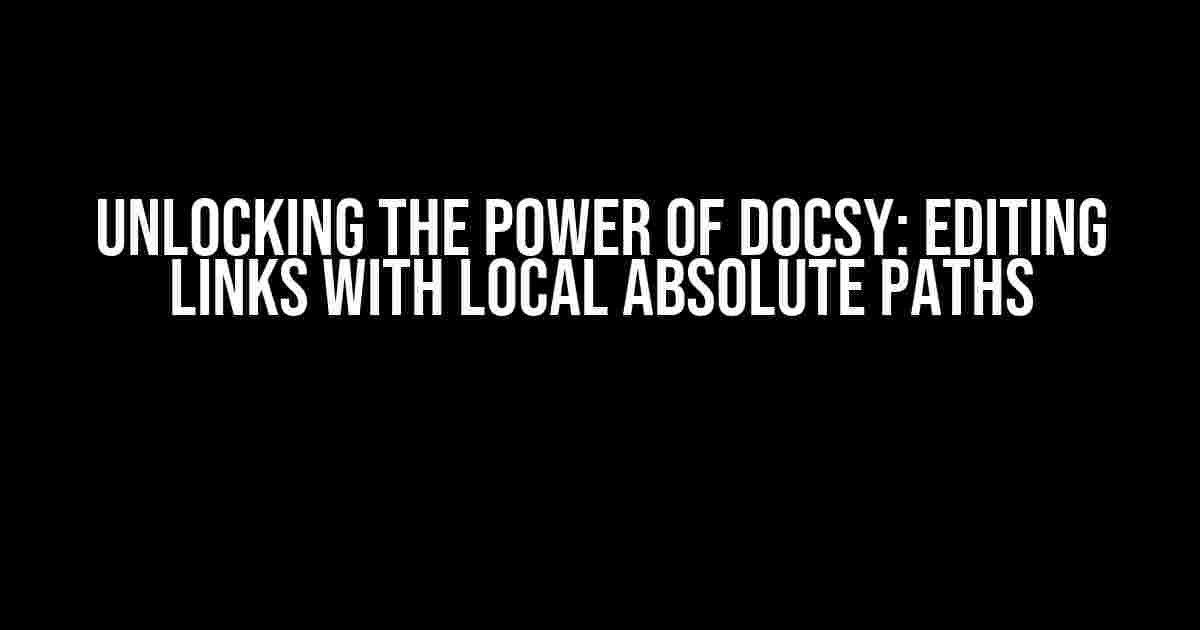Are you tired of dealing with messy and complicated URLs in your documentation? Do you struggle to maintain consistency across your links? Look no further! In this comprehensive guide, we’ll dive into the world of Docsy and explore how to generate edit links with local absolute paths.
What is Docsy, and Why Do I Need It?
Docsy is a popular documentation-as-code platform that allows you to create, manage, and deploy high-quality documentation with ease. With Docsy, you can focus on writing great content instead of worrying about the underlying infrastructure. One of the key features of Docsy is its ability to generate edit links for your documentation, making it easy for users to contribute and collaborate.
The Problem: Relative URLs and Broken Links
When working with relative URLs in Docsy, you might encounter issues with broken links and inconsistent URL structures. This can lead to frustration and confusion among users, especially when navigating between different sections of your documentation. That’s where local absolute paths come in – they provide a solution to this problem by generating links that are independent of the current URL.
Generating Edit Links with Local Absolute Paths
To generate edit links with local absolute paths in Docsy, you’ll need to follow these simple steps:
-
Create a new file in your documentation repository with a `.md` extension (e.g., `getting-started.md`).
-
In this file, add the following front matter:
--- editLink: {{< relref "getting-started.md" >}} --- -
In your `config.yaml` file, add the following configuration:
edit: base: /docs repository: https://github.com/your-username/your-repo-name
-
Build and deploy your documentation using Docsy.
What’s Happening Behind the Scenes?
When you use the `relref` function in Docsy, it generates a relative URL based on the current file location. By combining this with the `editLink` front matter, you can create a link that points to the edit page of the current file. The `base` and `repository` settings in your `config.yaml` file tell Docsy where to find the edit page and the GitHub repository associated with your documentation.
Local Absolute Paths in Action
Let’s take a closer look at an example to illustrate how local absolute paths work in Docsy:
| File Location | Relative URL | Local Absolute Path |
|---|---|---|
| /docs/getting-started.md | /getting-started.md | /docs/getting-started.md |
| /docs/features/advanced.md | ../features/advanced.md | /docs/features/advanced.md |
In the example above, the `relref` function generates a relative URL based on the file location. By using local absolute paths, we can ensure that the edit link always points to the correct location, regardless of the current URL.
Best Practices for Using Local Absolute Paths
To get the most out of local absolute paths in Docsy, follow these best practices:
-
Use local absolute paths consistently throughout your documentation to avoid confusion and broken links.
-
Avoid using hard-coded URLs, as they can lead to maintenance nightmares and broken links.
-
Keep your `config.yaml` file up-to-date and accurate, as it affects the generation of edit links.
-
Test your documentation thoroughly to catch any broken links or issues with edit links.
Troubleshooting Common Issues
If you encounter issues with edit links or local absolute paths in Docsy, try these troubleshooting steps:
-
Check your `config.yaml` file for errors or inconsistencies.
-
Verify that your GitHub repository is correctly configured and linked to your Docsy project.
-
Review your file structure and ensure that files are correctly linked and referenced.
-
Check the Docsy documentation and community resources for known issues and solutions.
Conclusion
In this comprehensive guide, we’ve explored the power of Docsy and how to generate edit links with local absolute paths. By following the steps and best practices outlined above, you can create a seamless and efficient documentation experience for your users. Remember to stay consistent, test thoroughly, and troubleshoot issues as they arise. Happy documenting!
Now, go ahead and take the first step in unlocking the full potential of Docsy – edit your documentation with confidence and ease!
Here are 5 Questions and Answers about “Docsy edit link are generate with local absolute path” in a creative voice and tone:
Frequently Asked Question
Got questions about Docusy edit links and local absolute paths? We’ve got answers!
Why do Docusy edit links generate with local absolute paths?
Docusy edit links generate with local absolute paths to ensure that the link is unique and points directly to the specific document on your local machine. This way, when you share the link with others, they can easily access the document without any confusion or versioning issues.
What is the benefit of using local absolute paths in Docusy edit links?
Using local absolute paths in Docusy edit links ensures that the link is not dependent on the browser’s current location or the document’s URL. This makes it easier to share and collaborate on documents, as the link will always point to the correct document, regardless of where it’s accessed from.
Can I customize the path of the Docusy edit link?
Yes, you can customize the path of the Docusy edit link by specifying a custom base URL in your Docusy settings. This allows you to control how the link is generated and makes it easier to integrate with other tools and platforms.
How do I share a Docusy edit link with others?
You can share a Docusy edit link with others by copying the link and sending it to them via email, messaging app, or any other sharing method. Make sure to give them access to the document and ensure they have the necessary permissions to edit the document.
Is it secure to share Docusy edit links with others?
Yes, sharing Docusy edit links is secure as long as you’ve set the proper permissions and access controls. Docusy edit links are generated with a unique token that grants access to the specific document, and you can revoke access at any time by updating the document’s permissions.
